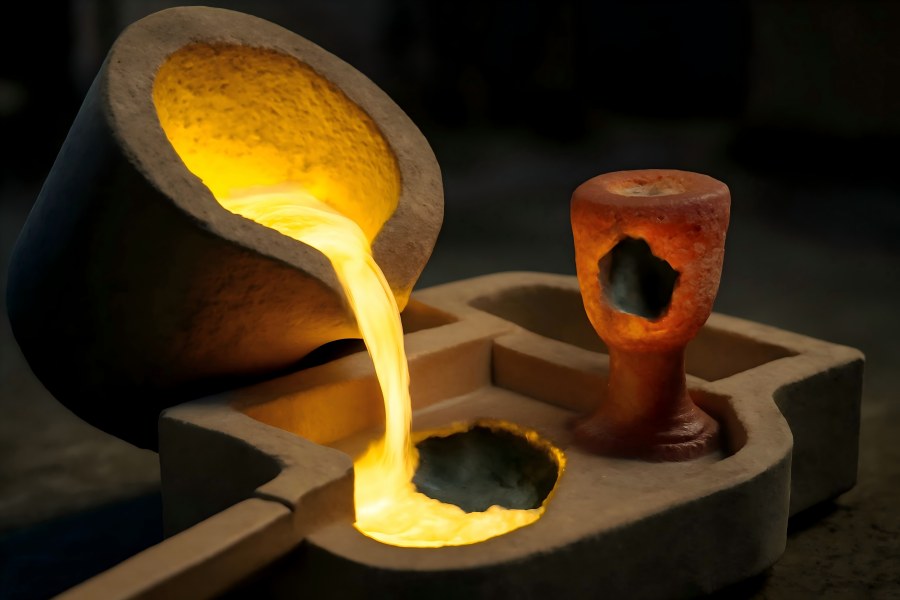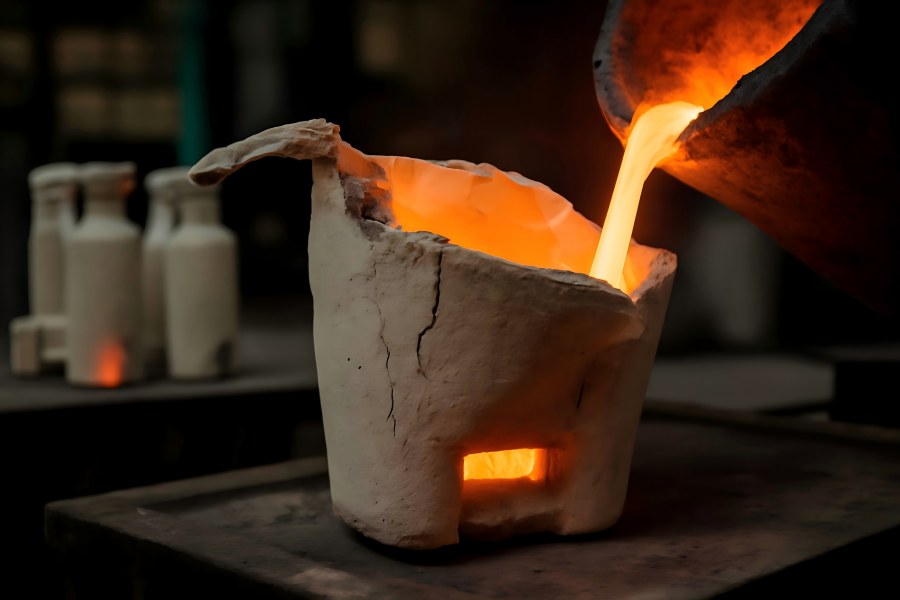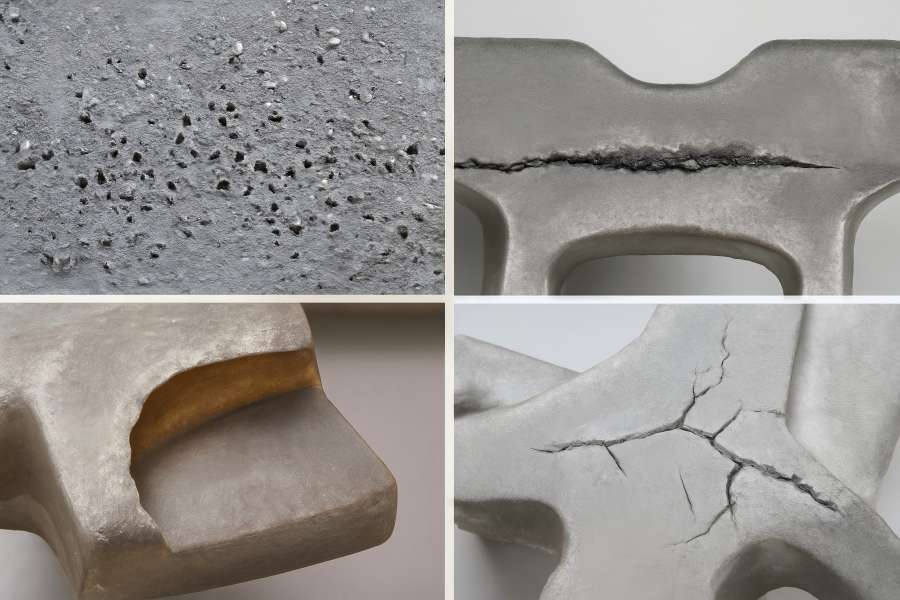A process that produces complicated metal pieces with exceptional dimensional accuracy is silica sol investment casting. It uses silica-based sol to create molds, allowing for high precision and minimal machining. Power generating, medical devices, automobiles, and aerospace all make extensive use of this method. However, casting defects can compromise product quality and performance.
This article explores ten common defects in silica sol investment casting and strategies to mitigate them.
1. Porosity
Porosity refers to the presence of voids or holes within the casting, which can significantly affect the mechanical properties of the final product, including its strength and durability. These voids may be caused by trapped gases or incomplete filling of the mold.
Causes:
- Trapped gases during solidification: As the molten metal cools and solidifies, gases such as air or water vapor can become trapped within the material.
- Insufficient venting in the mold: Porosity can result from a poorly designed mold that prevents gasses from escaping during the pouring operation.
Mitigation Strategies:
Manufacturers can use a variety of tactics to lower the danger of porosity:
- Increase the permeability of mold: Gases can escape during the casting process when more porous mold materials are used.
- Optimize the speed and temperature of pouring: Gas entrapment can be reduced by regulating the pouring speed and maintaining the proper pouring temperature.
- Put vacuum-assisted casting methods into practice: By eliminating air from the mold cavity before to the pouring of molten metal, vacuum-assisted casting lowers the possibility of porosity.
2. Cracking
Cracking occurs when the casting experiences thermal stresses due to uneven cooling or handling. It results in visible cracks that can weaken the integrity of the part.
Causes:
- Thermal tensions brought on by uneven cooling: Cracks may result from stresses created when various mold components cool at varying speeds.
- Insufficient shell strength: The mold shell might not be able to tolerate the forces during cooling if it is too weak.
Mitigation Strategies:
- Control cooling rates: Slow, uniform cooling prevents the buildup of thermal stresses. Cooling can be controlled using cooling fans or heat shields.
- Use of stress-relieving techniques: Heat treatment can be used to relieve the stresses in the casting after it has cooled.
- Improve shell material properties: Using stronger and more heat-resistant materials for the shell reduces the likelihood of cracking.
3. Shrinkage

Shrinkage occurs when the molten metal solidifies and contracts, creating internal voids or cavities. This flaw can be especially troublesome for items that need to be highly accurate in terms of dimensions.
Causes:
- Solidification shrinkage: The metal naturally compresses as it cools and solidifies.
- Improper gating system design: An inefficient gating system can prevent molten metal from flowing evenly into the mold, resulting in areas that are not fully filled.
Mitigation Strategies:
- Create suitable feeders and risers: Risers keep voids from forming by adding more molten metal to the casting as it shrinks.
- Utilize chills: Chills are used to promote controlled cooling in certain areas of the casting to reduce shrinkage.
- Optimize gating system layout: Ensuring that the gating system is designed to allow even flow of molten metal can help prevent areas of shrinkage.
4. Surface Defects
Surface defects, including roughness, inclusions, or misalignment, can mar the final appearance of the casting. These imperfections can result from contaminants in the mold or improper preparation.
Causes:
- Contaminants in the mold or shell: Dust, moisture, or oils can cause defects on the surface of the casting.
- Improper shell preparation: If the mold shell is not properly dried, cured, or cleaned, it can lead to surface irregularities.
Mitigation Strategies:
- Implement stringent cleaning protocols: Ensuring that the mold and shell are free from contaminants before pouring will reduce surface defects.
- Use high-quality shell materials: High-quality, well-processed shell materials help achieve a smooth surface.
- Ensure proper shell drying and curing: Thorough drying and curing processes help eliminate moisture or residual chemicals that could cause defects.
5. Inclusions
Foreign substances like slag, grit, or oxides that become stuck in the molten metal are known as inclusions. These substances have the potential to weaken and lower the overall quality of the casting.
Causes:
- Contaminants in the molten metal: If the metal is not properly filtered or cleaned, foreign materials can be included during the pouring process.
- Improper handling of materials: Using contaminated tools or equipment can introduce impurities into the molten metal.
Mitigation Strategies:
- Employ filtration systems: Before pouring, contaminants can be eliminated from the molten metal using filters.
- Maintain clean melting environments: Ensuring that the melting environment is free from contaminants reduces the likelihood of inclusions.
- Implement proper material handling procedures: Ensuring that materials are stored and handled properly prevents contamination.
6. Misruns
When the mold cavity is not fully filled during the casting process, a misrun happens. This defect can result in a part with missing sections or incomplete features.
Causes:
- Low pouring temperature: The molten metal may solidify before filling the mold all the way if it is too cool.
- Improper gating system design: An inefficient gating system can lead to incomplete filling of the mold.
Mitigation Strategies:
- Increase pouring temperature: Ensuring that the molten metal is hot enough to flow easily into all areas of the mold prevents misruns.
- Optimize gating system design: A properly designed gating system ensures that molten metal fills the mold completely.
- Ensure proper mold preheating: Preheating the mold ensures that the metal stays molten long enough to fill the entire mold cavity.
7. Cold Shuts
A visible seam is left in the casting when two streams of molten metal collide but do not properly fuse, a phenomenon known as a “cold shut.”
Causes:
- Low pouring temperature: If the metal is too cold, it may not flow smoothly and may fail to fuse at the joint.
- Poor mold design: Cold shuts can result from an uneven flow of molten metal caused by a poorly designed mold.
Mitigation Strategies:
- Increase pouring temperature: Ensuring the molten metal is hot enough to flow smoothly and fuse properly can prevent cold shuts.
- Improve mold design: Optimizing the design to ensure the smooth flow of molten metal can prevent cold shuts.
- Use gating systems that promote smooth metal flow: Effective gating systems ensure that the molten metal fills the mold evenly, reducing the risk of cold shuts.
8. Shell Deformation

Shell deformation occurs when the mold shell distorts due to thermal stresses or poor handling during the casting process.
Causes:
- Uneven heating: If the shell is not heated uniformly, it can deform during the casting process.
- Inadequate shell strength: A weak shell may collapse or distort under the forces generated during the pouring of the molten metal.
Mitigation Strategies:
- Implement uniform heating techniques: Ensuring that the mold is heated evenly helps prevent shell deformation.
- Enhance shell material properties: Stronger and more heat-resistant materials reduce the likelihood of deformation.
- Control mold handling procedures: Proper handling, including careful lifting and moving of molds, can prevent mechanical deformation.
9. Metal Penetration
Metal penetration is the process by which molten metal seeps into the mold material, giving the casting rough or porous surfaces.
Causes:
- High pouring temperatures: Pouring metal at excessively high temperatures can cause it to infiltrate the mold.
- Using subpar mold materials: Weak mold materials may not be able to withstand the molten metal, which could allow penetration.
Mitigation Strategies:
- Lower pouring temperatures: Reducing the pouring temperature helps prevent metal from infiltrating the mold.
- Use high-quality mold materials: Stronger mold materials prevent metal from penetrating.
- Apply mold coatings: Coatings can create a barrier that prevents the molten metal from penetrating the mold.
10. Veining
Veining occurs when thin, vein-like projections form on the surface of the casting. These projections can affect the aesthetic appearance and performance of the casting.
Causes:
- Thermal expansion of mold materials: As the mold material expands due to heat, it can create cracks that form veins in the casting.
- High pouring temperatures: Excessive pouring temperatures can exacerbate the issue by increasing thermal stresses.
Mitigation Strategies:
- Use of more refractory non-silica sands: Sands with higher refractory properties resist thermal expansion and help reduce veining.
- Lower pouring temperatures: Reducing pouring temperatures helps minimize thermal expansion and veining.
- Use of flux additives: Flux can lower the transition temperatures of the mold material, reducing veining.
Conclusion
Investment casting with silica sol is an effective method for creating parts with great precision. However, manufacturers must address common defects to improve casting quality, reduce costs, and enhance process efficiency. By understanding defect causes and implementing effective strategies, manufacturers can improve outcomes. Ongoing advancements, including automation and AI for defect detection, will further enhance the quality and reliability of silica sol investment casting.
